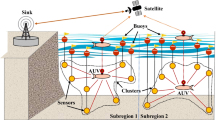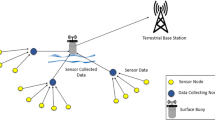Abstract
This study analyzes and summarizes seven main characteristics of the marine data sampled by multiple underwater gliders. These characteristics such as the big data volume and data sparseness make it extremely difficult to do some meaningful applications like early warning of marine environment. In order to make full use of the sea trial data, this paper gives the definition of two types of marine data cube which can integrate the big marine data sampled by multiple underwater gliders along saw-tooth paths, and proposes a data fitting algorithm based on time extraction and space compression (DFTS) to construct the temperature and conductivity data cubes. This research also presents an early warning algorithm based on data cube (EWDC) to realize the early warning of a new sampled data file. Experiments results show that the proposed methods are reasonable and effective. Our work is the first study to do some realistic applications on the data sampled by multiple underwater vehicles, and it provides a research framework for processing and analyzing the big marine data oriented to the applications of underwater gliders.
Similar content being viewed by others
References
Båmstedt, U. and Brugel, S., 2017. A cost-precision model for marine environmental monitoring, based on time-integrated averages, Environmental Monitoring and Assessment, 189(7), 354.
Bouffard, J., Pascual, A., Ruiz, S., Faugère, Y. and Tintoré, J., 2010. Coastal and mesoscale dynamics characterization using altimetry and gliders: A case study in the Balearic Sea, Journal of Geophysical Research: Oceans, 115(C10), C10029.
Chai, T. and Draxler, R.R., 2014. Root mean square error (RMSE) or mean absolute error (MAE)? Geoscientific Model Development Discussions, 7(1), 1525–1534.
Cheadle, C., Vawter, M.P., Freed, W.J. and Becker, K.G., 2003. Analysis of microarray data using Z score transformation, The Journal of Molecular Diagnostics, 5(2), 73–81.
Dobricic, S., Pinardi, N., Testor, P. and Send, U., 2010. Impact of data assimilation of glider observations in the Ionian Sea (Eastern Mediterranean), Dynamics of Atmospheres and Oceans, 50(1), 78–92.
Dong, L., Li, L., Li, Q.Y., Wang, H. and Zhang, C.L., 2015. Hydroclimate implications of thermocline variability in the southern South China Sea over the past 180,000 yr, Quaternary Research, 83(2), 370–377.
Fang, S.F., Xu, L.D., Zhu, Y.Q., Liu, Y.Q., Liu, Z.H., Pei, H., Yan, J.W. and Zhang, H.F., 2015. An integrated information system for snowmelt flood early-warning based on internet of things, Information Systems Frontiers, 17(2), 321–335.
Fiorelli, E., Leonard, N.E., Bhatta, P., Paley, D.A., Bachmayer, R. and Fratantoni, D.M., 2006. Multi-AUV control and adaptive sampling in Monterey Bay, IEEE Journal of Oceanic Engineering, 31(4), 935–948.
Jiang, P., Liu, X., Zhang, J. and Yuan, X., 2016. A framework based on hidden Markov model with adaptive weighting for microcystin forecasting and early-warning, Decision Support Systems, 84, 89–103.
Montgomery, D.C., Peck, E.A. and Vining, G.G., 2015. Introduction to Linear Regression Analysis, John Wiley & Sons, New York.
Park, S. and Lee, S.R., 2014. Red tides prediction system using fuzzy reasoning and the ensemble method, Applied Intelligence, 40(2), 244–255.
Park, Y., Cho, K.H., Park, J., Cha, S.M. and Kim, J.H., 2015. Development of early-warning protocol for predicting chlorophyll-a concentration using machine learning models in freshwater and estuarine reservoirs, Korea, Science of The Total Environment, 502, 31–41.
Pieri, G., Cocco, M. and Salvetti, O., 2018. A marine information system for environmental monitoring: ARGO-MIS, Journal of Marine Science and Engineering, 6, 15.
Qiu, C.H., Mao, H.B., Yu, J.C., Xie, Q., Wu, J.X., Lian, S.M. and Liu, Q.Y., 2015. Sea surface cooling in the northern South China Sea observed using Chinese sea-wing underwater glider measurements, Deep Sea Research Part I: Oceanographic Research Papers, 105, 111–118.
van der Aalst, W.M.P., 2013. Process cubes: Slicing, dicing, rolling up and drilling down event data for process mining, Proceedings of the 1st Asia Pacific Conference on Business Process Management, Springer, Beijing, pp. 1–22.
Vasilijević, A., Nađ, D., Mandić, F., Mišković, N. and Vukić, Z., 2017. Coordinated navigation of surface and underwater marine robotic vehicles for ocean sampling and environmental monitoring, IEEE/ASME Transactions on Mechatronics, 22(3), 1174–1184.
Xu, Z.Z., Jia, M.F., Li, L., Yu, S., Yu, J.C. and Liu, S.J., 2016. Data preprocessing and fitting algorithm based on marine data sampled by multiple underwater gliders, Proceedings of the 12th World Congress on Intelligent Control and Automation, IEEE, Piscataway, pp. 1036–1041.
Yu, J.C., Zhang, F.M., Zhang, A.Q., Jin, W.M. and Tian, Y., 2013. Motion parameter optimization and sensor scheduling for the seawing underwater glider, IEEE Journal of Oceanic Engineering, 38(2), 243–254.
Zhang, S.W., Yu, J.C., Zhang, A.Q. and Zhang, F.M., 2011. Steady three dimensional gliding motion of an underwater glider, Proceedings of 2011 IEEE International Conference on Robotics and Automation, IEEE, Shanghai, pp. 2392–2397.
Zhang, S.W., Zhang, A.Q. and Yu, J.C., 2015. Ocean observing with underwater glider in South China Seas, Proceedings of 2015 IEEE International Conference on Cyber Technology in Automation, Control, and Intelligent Systems, IEEE, Shenyang, pp. 1109–1114.
Zheng, G.Z., Zhu, N., Tian, Z., Chen, Y. and Sun, B.H., 2012. Application of a trapezoidal fuzzy AHP method for work safety evaluation and early warning rating of hot and humid environments, Safety Science, 50(2), 228–239.
Zollo, A., Lancieri, O., Lancieri, M., Wu, Y.M. and Kanamori, H., 2010. A threshold-based earthquake early warning using dense accelerometer networks, Geophysical Journal International, 183(2), 963–974.
Author information
Authors and Affiliations
Corresponding author
Additional information
Foundation item: This work is financially supported by the National Natural Science Foundation of China (Grant Nos. U1709202 and No. 61502069), the Foundation of State Key Laboratory of Robotics (Grant No. 2015-o03) and the Fundamental Research Funds for the Central Universities (Grant Nos. DUT18JC39 and DUT17JC45).
Rights and permissions
About this article
Cite this article
Xu, Zz., Li, L., Yu, Jc. et al. A Marine Environment Early Warning Algorithm Based on Marine Data Sampled by Multiple Underwater Gliders. China Ocean Eng 33, 172–184 (2019). https://doi.org/10.1007/s13344-019-0017-5
Received:
Revised:
Accepted:
Published:
Issue Date:
DOI: https://doi.org/10.1007/s13344-019-0017-5




